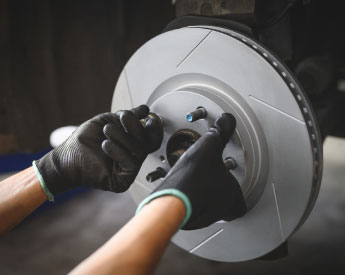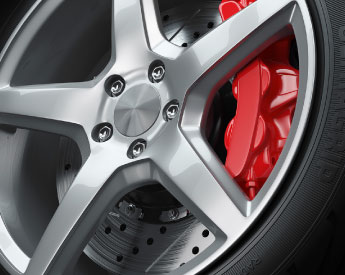Vehicle safety and technologies have made great progress especially in recent years. The bodies and cabin parts of the vehicles are strengthened, airbags become standard and different safety elements are added to the vehicles.

The brake systems, which are the critical parts of these systems, prevent possible collisions and accidents and protect both us and other drivers and pedestrians in the traffic.
For this reason, in this article, we will examine the brake systems in vehicles and look at their types. But first of all, what is the automobile brake system, let's start from there if you wish.

What is the Brake System?
Brake refers to the mechanism used to reduce the speed of a vehicle or to stop its movement. Brake systems, on the other hand, describe systems that are mostly found in motor vehicles and have more complex structures.
This mechanism for slowing or stopping the vehicle must not be weak, as a weak braking system will not be sufficient to slow the vehicle safely.
While designing this system, the condition of the vehicle is taken into consideration and the braking system is added to the vehicle in the most appropriate and balanced way.
In primitive and old brake systems, when you press your foot on the brake pedal, the wheels were locked with the help of discs. However, modern brake systems are used in today's cars, and thanks to these systems, situations such as skidding, locking or overturning of the vehicles are tried to be prevented.
How Automobile Brake Systems Work?
The stronger and more stable the brake systems in the vehicles, the safer the vehicles are. Different systems are used together to ensure this safety in modern vehicles used today.
But basically, when the brake pedal is pressed, the hydraulic fluid in the system changes and this change is transmitted to the brake discs by means of a piston. The effect of the friction force on the disc also causes the vehicle to slow down and stop.
The more force applied, the more pressure the brake discs are subjected to and the slower the rotational speed of the wheel. Disc brakes are mostly located at the front of the vehicles, but disc brakes can be found on all four wheels of the vehicles. But it's the front where the brakes really matter.
Because the best braking is done by the front wheels, and the effect of braking is felt mainly on the front wheels.
Types of Brake System
Brake systems and their types; It varies according to the models, sizes or features of the vehicles. The most used brake systems today are as follows:
Hydraulic Brake System
Hydraulic brake uses hydraulic oil pressure to operate the vehicle's braking system. The working principle of this system is quite simple. When the brake is pressed, the piston moves and the calipers are closed by the pressure of the oil in the hydraulic mechanism.
When the calipers are closed, the brake pads and the discs on the wheels stick together. This allows the vehicle to slow down or stop.
Air Brake System
Air brake systems are mostly used in vehicles called heavy vehicles or heavy commercial vehicles. This system works with a device called an air compressor and the air is released as soon as the brake is pressed. The discharge of air enables braking.
Braking is not possible in hydraulic brake systems when oil runs out. However, this is not the case with air brake systems. In this system, the vehicle tries to stop when the air is discharged.
ABS Brake System
The ABS braking system, which is "Anti-lock Braking System" in English and is used as "Anti-Lock Braking System" in Turkish, prevents the wheels of the vehicles from locking up during sudden braking.
This brake system, which was invented to prevent the hydraulic brakes from locking the vehicle wheels, is intended to provide dominance on the steering wheel. This system turns one wheel less than the others, or engages when a wheel is not turning, reducing braking on that wheel.
ASR Brake System
ASR braking system is a system developed to prevent the vehicle from skidding. ASR, which means "Anti Skid System", works together with the ABS system and is activated if the vehicle starts to skid.
ESP System
The "Electronic Stability Program", or the ESP braking system for short, is a system developed to prevent the vehicle from skidding. However, this system works in conjunction with ABS and ASR systems. This system, which monitors the movements of the drivers, activates in case of any imbalance or skidding and ensures that the vehicle stays on the road safely.
EBD System
The EBD system, which stands for "Electronic Brake Force Distribution" and is translated into Turkish as "Electronic Brake Force Distribution System", serves to equalize the power distribution in the rear and front brakes. Under normal conditions, the vehicle lifts from rear to front when braking. Thanks to the EBD system, the power of the vehicle's brakes is regulated and the rear part is brought closer to the ground.
BAS System
BAS system is an emergency system. This system, which aims to save time for drivers in sudden braking, helps to give the necessary reaction even if a low pressure is applied to the brake.
Magnetic Braking System
Magnetic braking system, also known as engine brake, is the general name of the deceleration forces in the vehicle. The engine starts to slow down when the accelerator pedal is released and stops after a while due to these slowing forces.
MSR System
MSR system is short for "Engine Brake Regulation System". This system tries to prevent the vehicle from slipping on slippery surfaces.
Hill Start Assist System
Hild Holder, also known as Hill Start Assist System, is the general name of the braking system that prevents the vehicle from slipping on a slope or any inclined area. When you want to start your vehicle on a slope or on a hill, the Hild Holder system applies braking to the clutch engagement point of your vehicle. When you step on the gas, braking stops and your vehicle moves safely.
EPB System
In the EPB system, also called "Electronic Parking Brake", the brake calipers of the car and the engine are connected to each other. This system has been developed especially for passenger vehicles. It is used to keep the vehicle stable on flat roads and ramps. The EPB system is traditionally used as a parking brake and is activated by a button often located on the console. This system basically replaces the handbrake.



Janet Lopez